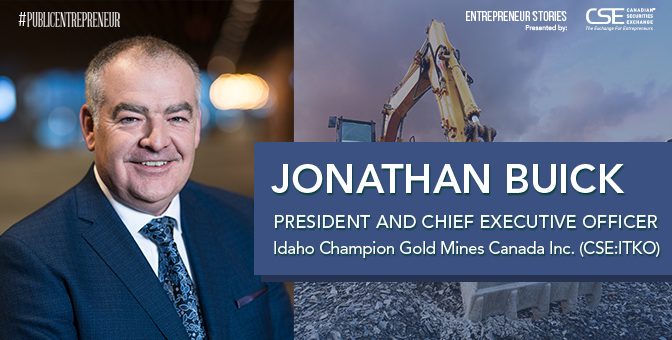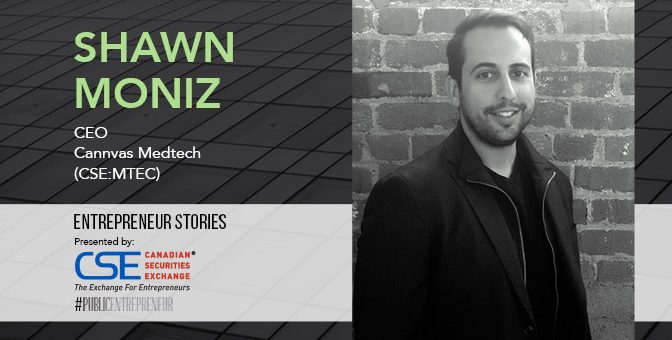From his offices in Toronto, Jonathan Buick sees the glitter of opportunity more than 2,000 miles away. On the outskirts of Elk City, Idaho, is Buick’s Xanadu, the Baner project, where he has just struck gold.
“We drilled 19 holes and we hit mineralization on every hole. The further to the north we got, the shallower it was and the better the grade,” says Buick of the 1,705 hectare exploration site.
If history is any guide, Baner’s potential is substantial to say the least. The Elk City area had numerous alluvial gold deposits dredged from the tributaries of the Clear Water River, which runs through it, between the 1850s and the late 1980s. And Crooked Creek, an area just north of the Baner project, yielded about 1.5 million alluvial ounces between 1880 and 1910.
Before moving to acquire Baner in November of 2016 and set up Idaho Champion Gold Mines Canada Inc. (CSE:ITKO) via a reverse takeover, Buick and his colleagues reviewed over 250 gold projects globally. The scope of the search was narrowed to places within an appropriate time zone and a favorable, English language legal jurisdiction. Idaho emerged as the best bet.
“We’re in a good environment. We have great relationships with various agencies and both the US Forest Service and the Bureau of Land Management. They’ve been very supportive. We’ve also made it a real focus to try to hire as many of the local people as we can,” says Buick. “We think it’s important for people to know that we’re here to be good stewards, but also to participate in the economy.”
Baner was purchased for US$500,000 from a local family, who had owned it since the 1890s. Last June, the first exploration of the site in modern times began.
Idaho Champion’s first drilling effort at Baner yielded a discovery zone which is about 500 meters north to south by 200 meters east to west. As much as 5,200 meters of core was drilled in 19 holes as part of this maiden campaign. And the results included an assay from a hole which intersected 5.76 grams of gold per tonne over 12.65 meters.
The company recently purchased six additional claims, which allows it to increase its strike length a further 2 kilometers.
“I believe that we have only scratched the surface on our first exploration program at Baner. We have made a new gold discovery through the drill bit and encountered great initial grades in the highly oxidized zones near the surface,” said Buick. “There was good continuity in the holes and our newly acquired Sally claims will provide us the opportunity to expand the strike length an additional 2 km to the north.”
Particularly exciting is that the drill results show highly oxidized zones near the surface, which improves the grades and makes the gold project “much more economically attractive.”
The results at Baner are being analyzed to plan the exploration program for this year’s field season. Baner remains Idaho Champion’s focus, but just a couple of counties away sits the Toronto company’s second gold project, Champagne, not far from Arco, which it staked in February of 2018.
While the property was in production from 1990 to 1993 as a heap leach gold mine, the previous owners never drilled below 100 meters. Idaho Champion’s geologists think there’s a much bigger system at the 10 square kilometer property that could be characterized by “Midas”-type deposits, consisting of high-grade gold and silver epithermal systems. “We think there’s a much bigger target and a much bigger system underneath,” says Buick. “Our goal in 2019 is to go ahead and do some grassroots exploration.”
Buick is a businessman who likes to have options as a hedge against uncertainty. So, last November, in a bid to diversify, Idaho Champion purchased 822 federal US cobalt mining claims in four blocks – Victory, Fairway, Twin Peaks and Ulysses – (about 6,871 hectares) in the Idaho Cobalt Belt, just outside of Salmon, Idaho, from American Cobalt Corp. for a price of 4 million shares. Buick reports that his investors supported the move.
“When we picked up the cobalt, I went out to each of my investors and said I’m going after some cobalt because I think it’s important to have exposure to the market and also to protect us should we not be successful at Baner,” notes Buick.
Despite a sharp price correction in 2018, growing demand for lithium-ion battery elements are predicted to sustain cobalt prices into the 2020s. And the Idaho Cobalt belt represents a top district for primary cobalt discoveries.
“The standalone cobalt groups are having a challenge finding the capital. But that’s a pause in the market,” says Buick. “Cobalt is going to continue to be a focus and a priority for the end user and capital will come back into the cobalt space. I’m very confident that cobalt will again shine.”
Field work including site surveys, ridge & spur soil sampling, rock sampling and geologic mapping kicked off at Idaho’s four cobalt ventures last November in a bid to gather information for a more robust effort this year.
Buick describes the four cobalt projects as “life jackets” offering protection on the Baner program. Thanks to the recent gold discovery, it looks likely that the cobalt projects will be used to support the work at Baner. “If we had been unsuccessful at making the discovery, we would look to change our focus and apply it to spending on the cobalt,” explains Buick. “We’re now in active conversations with third parties to allow for the monetization of the cobalt to allow us to expand on our gold focus.”
Under review now is whether to spin out the cobalt projects into a new company; to sell them and keep an interest; or bring in a partner. “Right now, we’re reviewing all of those options on the cobalt that will allow us to come back and focus on the gold,” Buick reports.
Having raised more than $400 million throughout his lengthy tenure in finance, Buick, who specializes in securing strategic capital in Korea and Japan as a managing director of Harp Capital and his own investment firm, enjoys a reputation as a money finder.
Before Idaho Champion started trading on the CSE at the end of September, Idaho raised more than US$3 million. It remains pre-revenue, however, and posted a net loss of C$2.36 million in the three months until the end of September, according to its latest regulatory filing statement.
But business is percolating, and Buick is confident that money can be found. “We have shareholders who said they would commit to the next source of funding when that is needed,” he says. He also points out that the company is not only engaged in conversations about its cobalt projects, but it’s also been approached by some larger gold companies about how they can participate in Baner.
Over the next two years, Buick intends to make the mission of Idaho Champion as public as he possibly can. “We’re a newly minted company on a project that hasn’t had modern exploration,” he concludes. “In our first program of exploration we made a discovery, but we’re an unknown story. It’s my job now to get out and get in front of the investor.”
This story was originally published at www.proactiveinvestors.com on March 8, 2019 and featured in the Public Entrepreneur magazine.
Learn more about Idaho Champions Gold Mine at http://www.idahochamp.com/.


